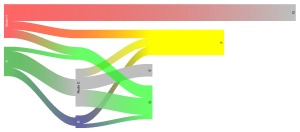Prompted by this cross-validated discussion, I have created the riverplot package. Here is a minimal gallery of the graphics produced by the package:
Here is an example which recreates the famous Minard plot:
So, how to do these figures:
First, you need to create a specific riverplot object that can be directly plotted. (Use riverplot.example to generate an example object). Here, I show how to recreate the Minard plot using the provided data. makeRiver, the function that will create the object necessary for plotting, will use data frames to input information about nodes and edges, but we must use specific naming of the columns:
library( riverplot ) data( minard ) nodes <- minard$nodes edges <- minard$edges colnames( nodes ) <- c( "ID", "x", "y" ) colnames( edges ) <- c( "N1", "N2", "Value", "direction" )
Now we can add some style information to the “edge” columns, to mimick the orignal Minard plot:
# color the edges by troop movement direction edges$col <- c( "#e5cbaa", "black" )[ factor( edges$direction ) ] # color edges by their color rather than by gradient between the nodes edges$edgecol <- "col" # generate the riverplot object river <- makeRiver( nodes, edges )
The makeRiver function reads any columns that match the style information (like colors of the nodes) and uses it to create the river object. The river object is just a simple list, you can easily view and manipulate it — or create it with your own functions. The point about makeRiver is to make sure that the data is consistent.
Once you have created a riverplot object with one of the above methods (or manually), you can plot it either with plot(x) or riverplot(x). I enforce the use of lines, and I also tell the plotting function to use a particular style. The default edges look curvy.
style <- list( edgestyle= "straight", nodestyle= "invisible" ) # plot the generated object plot( river, lty= 1, default.style= style ) # Add cities with( minard$cities, points( Longitude, Latitude, pch= 19 ) ) with( minard$cities, text( Longitude, Latitude, Name, adj= c( 0, 0 ) ) )

